
|
xTuple ERP Reference Guide |
Many users of xTuple ERP have a company policy to accept returned goods. To adequately handle this situation they need a mechanism to keep a record of what goods have been authorized for a return, credit, or other disposition. A return authorization is an internal approval system to resolve a problem resulting from dissatisfaction with products or services shipped. Depending on the business model, users may handle the return in a number of ways. The xTuple ERP return system is flexible enough to handle the needs of most business scenarios.
To access the Return Authorization window, go to . Return authorizations must be enabled in sales configuration. A return authorization appears as follows:
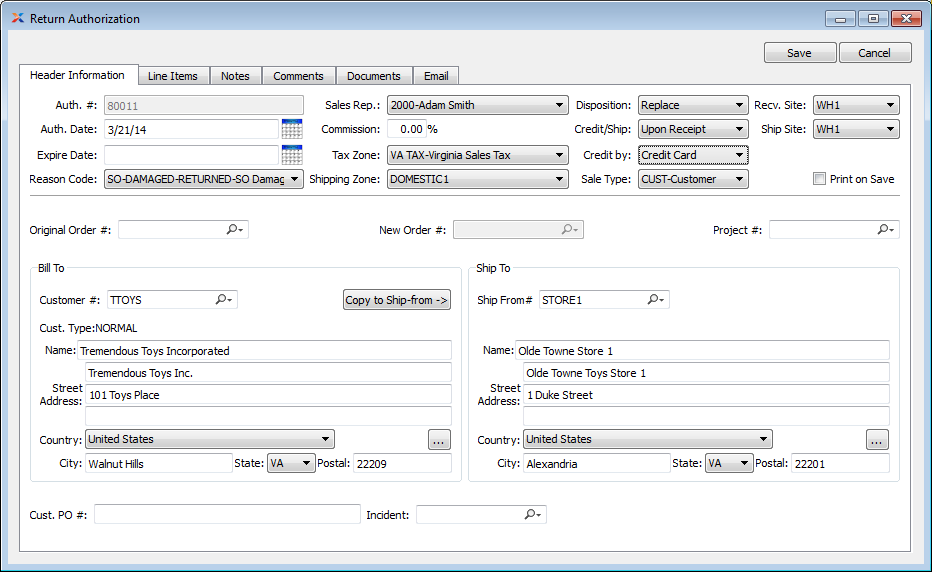
When creating a new return authorization, you are presented with the following options:
Next available return authorization number will automatically display, unless your system requires you to enter return authorization numbers manually. Default values and input parameters for return authorization numbers are configurable at the system level.
Displays current day's date.
Specify the date when the return authorization will expire. This is an optional setting used to determine the amount of time that should pass before the transactions on the return authorization are considered past due. When used, return authorizations cannot be received after their expiration date.
Specify the reason for the return authorization. Reason codes are used to explain why a customer return is being authorized.
Specify the sales representative associated with the return authorization. Sales representatives are linked to a customer on the Customer master—either by a default setting or through the assignment of ship-to addresses. Each ship-to address may have a different sales representative associated with it. Consequently, the name of the sales representative appearing on the return authorization header will be the same as specified for the ship-to address being used.
By default, the commission percentage recorded on the Customer master will be automatically entered in this field. If for some reason you select a non-default sales representative, the commission rate will not change. To adjust the commission rate, you must make the change manually.
Specify the tax zone associated with the return authorization. The tax zone for the specified ship-to address will be entered here by default. Otherwise, the primary tax zone for the customer will be entered.
Specify the shipping zone associated with the return authorization. The shipping zone for the specified ship-to address will be entered here by default. Otherwise, the primary shipping zone for the customer will be entered.
Specify the method to be used for handling the return authorization. If your system is configured to use a default disposition, then that value will be shown.
The disposition of individual line items will be determined conditionally based on the settings made at the return authorization header level.
Select to authorize the issuing of credit to the specified customer. No return is required or expected; as a result, the credit/ship timetable option will be disabled for this disposition method. Return authorization line items will close when an associated credit memo is posted.
Select to authorize returns from the specified customer. Return authorization items will close when an associated credit memo is posted, or when all items on a line have been returned, whichever comes last.
Select to authorize the replacement of items returned by the specified customer. Authorized quantities will be added as additional order quantity to a new associated sales order. Return authorization items will close when all items on the line have been returned or all authorized items on the line have been shipped, whichever comes last. Any money to be credited to the customer is set on the return authorization line; any money to be billed to the customer is set at the new sales order line.
Select to authorize the repair or service of items returned by the specified customer. To isolate costing implications, only job items may be selected. A new sales order with linked work order(s) will be created to track work and shipping on the repair or service. Service or repair items should first be received by the return authorization. If the job item is lot/serial controlled, you will be prompted to assign lot/serial numbers when the receipt is posted. This assignment of lot/serial numbers can be simplified if you link authorized line items with existing lot/serial numbers at the line item level. For more information, please see Section 4.1.1.1, “Return Authorization Item Lot/Serial”.
Money to be billed for service or repair should be set at the new sales order.
Select to authorize the substitution of items returned by the specified customer. Under this option, when an original sales order is imported into the return authorization, the return authorization line items will default to the return disposition. Any new line items added beyond the original ones will have a default disposition of .
Specify the timing for the return authorization:
Select to issue credit or send returns to the specified customer immediately.
Select to issue credit or ship new associated sales order items only after you have received the returned goods.
Specify the method to be used for crediting the customer:
Select if you will not be issuing credit to the customer. If you select this option, you will be unable to add pricing information at the return authorization line item level.
Select to credit the return with a sales credit to the customer's account. If selected, a sales credit will be automatically queued up for processing on the Return Authorizations workbench.
Select to credit the return by sending the customer a payment. If selected, a customer payment will be queued up for processing on the Return Authorizations workbench. When the payment is processed, a sales credit will be created automatically—and the payment will be applied to it.
Select to credit the return with a refund to the customer's credit card. If selected, the payment will be queued up for processing on the Return Authorizations workbench. A credit memo will be posted when the refund is processed—and the refund charges will be applied to it. If the timing of the credit is immediately, then you may issue the refund directly from the tab of the return authorization.
The credit card functionality must be enabled at your site for the credit card method to function properly.
Specify the sale type.
Specify the receiving site.
Specify the shipping site.
Select to print a copy of the return authorization when you select the button. You must have a form keyed on return authorizations for this option to work. The keyed on process is described here: Section 13.2.9.1, “Form”.
You have the option to select an original sales order for all disposition types. When an original sales order is selected, all line items from the original order will be imported into the return authorization automatically. For dispositions credit and return this feature imports the original pricing and billing information. When a sales order number is selected, the customer number and address information will be populated and disabled. If the customer is selected first, only sales orders for that customer will appear on the search list.
A sales order may be linked to only one open return authorization at a time.
For return authorizations having either replace, service, or substitute dispositions, the system will automatically generate a new sales order for shipping purposes when the line item is received and posted. Authorized line item quantities are added automatically to the new sales order, enabling you to ship the quantity at the appropriate time.
If your system is configured to you projects, you will have the option to select a project number to associate with the return authorization. This enables you to link the return authorization with other orders linked to the same project. The button located to the right of the field enables you to select from a list of available projects.
When you have the xTuple Project Accounting package installed—and you link a project to the return authorization—transactions related to the return authorization will include the project number as the final segment of affected G/L account numbers. Account numbers related to the following transactions will include project number as the final segment: issue to shipping, return stock, ship shipment, recall shipment, and post invoice.
Enter the customer number of the customer whose return you are authorizing. The lookup feature located to the right of the field leads to a searchable customers list. You may also access this list using the keyboard shortcut .
A valid customer number must be entered in the Customer # field before line items can be added to a return authorization for all disposition types except return. If no valid customer number is entered, you will not be able to add line items to the return authorization. Additionally, return authorizations may only be entered for active customers.
Displays the customer type for the specified customer.
Displays the customer's bill-to name.
Displays the customer's bill-to phone number.
Displays the customer's bill-to address. You may manually override the displayed address information in the fields below—or use the lookup feature to select another address. If a new address is manually entered here, that address will be added automatically to the master list of addresses. For additional documentation related to creating addresses, see Section 8.1, “ New Address”.
Select to copy contents of billing address into Ship-To Address field. This option is enabled if the Customer master for the specified customer indicates that free-form ship-tos are allowed.
Enter the number of the preferred ship-to address. Customers may maintain multiple ship-to addresses. If the Customer master for the specified customer indicates that free-form ship-tos are allowed, then any address may be entered. If free-form ship-tos are not allowed, then the ship-to address must be entered using the button located to the right of the field.
Displays the name for the specified ship-to.
Displays the phone number for the specified ship-to.
Displays the specified ship-to address. You may manually override the displayed address information in the fields below—or use the lookup feature to select another address. If a new address is manually entered here, that address will be added automatically to the master list of addresses. For additional documentation related to creating addresses, see Section 8.1, “ New Address”.
Enter a customer purchase order number, as needed.
You have the option to associate an incident number with the return authorization. The lookup feature located to the right of the field enables you to select from a list of available projects.
To create or modify return authorization line items, select the tab at the top of the Return Authorization screen. The following screen will appear:
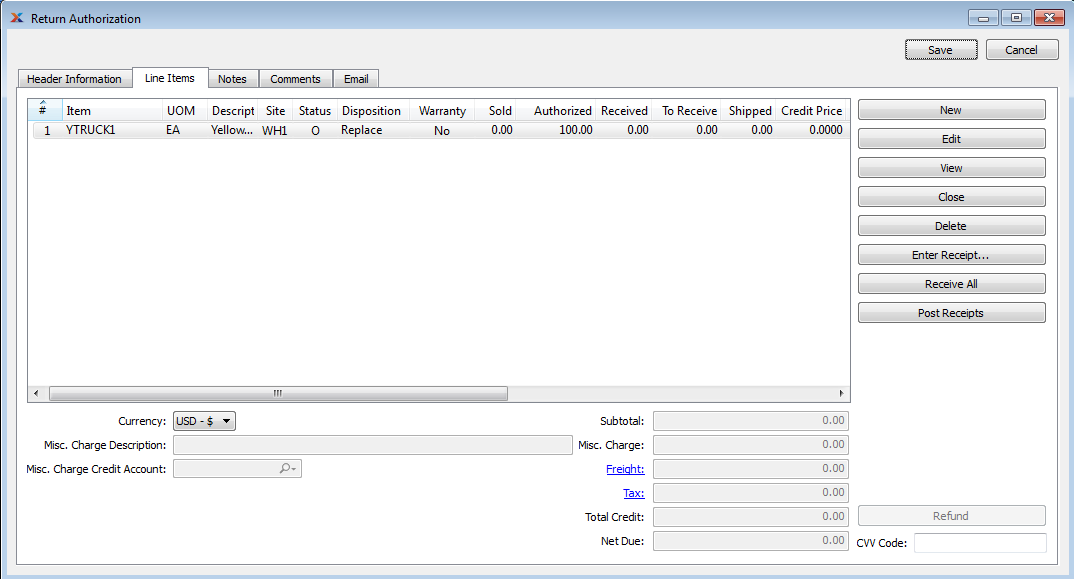
When creating or modifying return authorization line items, you are presented with the following options:
Display lists line items for this return authorization. A valid customer number must be entered in the Customer # field before line items can be added to the return authorization for all dispositions except return. For kit items, the kit components will be given sub line numbers which will be displayed in an indented view.
Select which currency will be used for this return.
Enter a description to identify the miscellaneous charge.
Enter a credit account to assign the miscellaneous charge to.
Displays the subtotal for the return authorization line items.
Enter the amount of any miscellaneous charge. Before entering a miscellaneous charge amount, you must first assign the charge to a sales account and also enter a description of the charge.
You may only enter miscellaneous charges on a return authorization only when a valid credit method is selected and a credit amount has been specified for one or more line items. Once a credit memo has been created against the return authorization, the header amounts may not be subsequently modified.
Manually enter the amount of freight charge to be credited on the specified return authorization, unless the freight amount is automatically calculated. The freight amount displayed here represents the total for all line items. To get a detailed view of the freight calculation, click on the link using your mouse. Freight charges may be entered during the creation or modification of a return authorization—or at the time of shipment. The system can be configured to automatically calculate freight amounts per quantity and shipment. To learn more about freight configuration, see Freight Pricing.
If you are manually entering freight, all freight charges will be added to the initial shipment for an order. Any subsequent backorder shipments will not include freight.
Displays the total amount of tax to be charged on the return authorization. The tax amount displayed here represents the total for all line item tax amounts. To get a detailed view of the tax calculation, click on the link using your mouse.
Displays the total amount of the return authorization credit.
Displays the total net due. The net is determined by adding the total credits with the total sales. If the amount is a negative number, this means the customer owes you money.
Enter the card verification value (CVV) code found on the back of the specified credit card. This may be an optional feature at your site. Contact your systems administrator for details.
The following buttons are unique to this screen:
Highlight a return authorization line item and then select this button to authorize the line item quantity. This option is available only when an imported original sales order is being used—and then, the original line item quantity must be shipped before it may be authorized.
Highlight a return authorization line item and then select this button to change the authorization quantity to zero for the line item.
Select to authorize the full quantity for all unauthorized line items. This option is available only when an imported original sales order is being used—and then, the original line item quantity must be shipped before it may be authorized.
Highlight an authorized return authorization line item and then select this button to receive the authorized quantity. The received quantity will be saved for subsequent posting.
Select to automatically receive all authorized line item quantity. The received quantities will be saved for subsequent posting.
Select to post all pending receipts for the return authorization.
Select to issue the specified customer a refund on their credit card. This option is only available for credits issued by credit card. Your system must also be configured to use credit cards for this option to work.
If you are using the Authorize.Net payment gateway, refunds must be processed at least one day after the original charge. Authorize.Net does not allow you to refund a transaction that was charged on the same day.
Enter the card verification value (CVV) code found on the back of the specified credit card. This may be an optional feature at your site. Contact your systems administrator for details.
Order notes added to a return authorization are used for internal purposes only. To add notes to a return authorization, select the tab at the top of the Return Authorization screen. The following screen will appear:
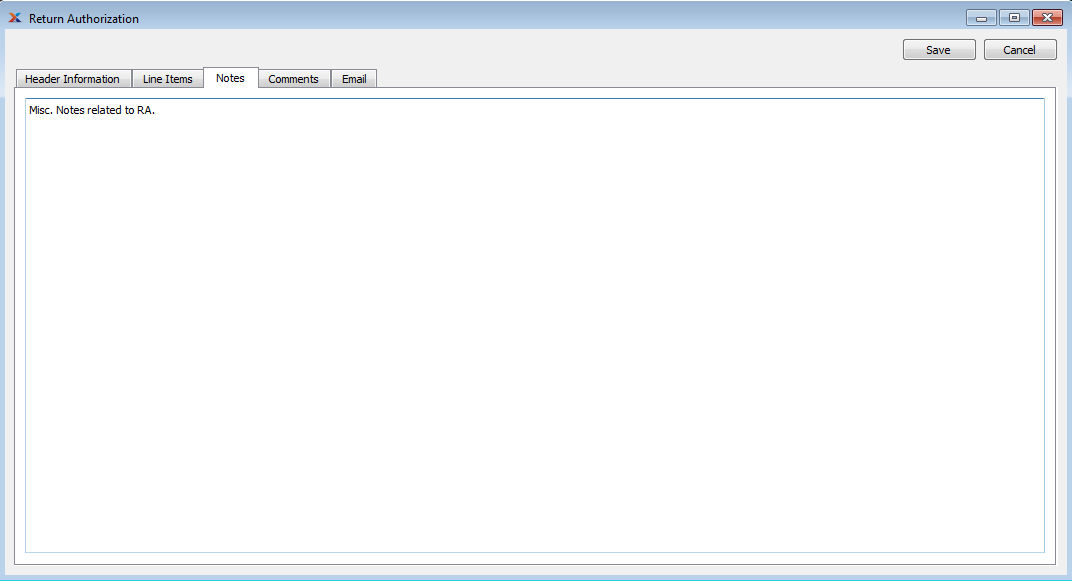
When adding notes to a return authorization, you are presented with the following options:
This is a scrolling text field with word-wrapping for entering general notes related to the return authorization. These notes are for internal use only.
To add comments related to a return authorization, select the tab. The following screen will appear:
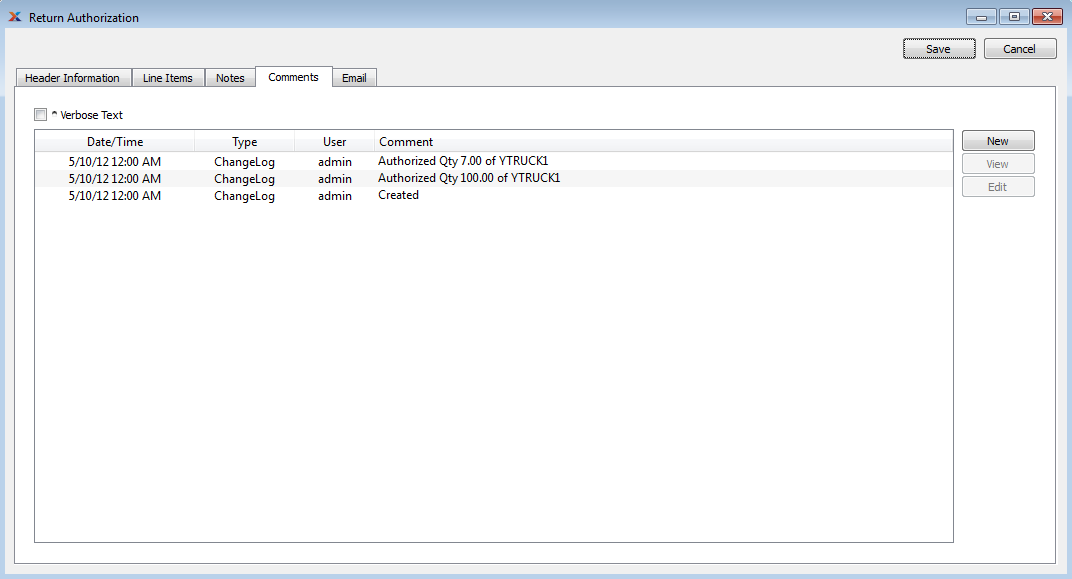
When adding or reviewing comments, you are presented with the following options:
Select to display all comments in the list in an expanded view which includes the entire text of each comment. To edit a comment, simply select the link next to the comment. That link will not be shown for changelog comments, which can't be edited. If the Verbose Text option is not selected, the comment list will display only header level information for each comment.
Display lists comments related to the record.
The following buttons are available:
Opens screen for creating a new comment.
Highlight a comment and then select this button to reach a read-only view of the Edit screen.
Enables you to edit highlighted comments—as long as the comments are not changelog comments. ChangeLog comments are system-generated and may not be edited. The Edit screen is the same as that for creating a new comment—except that when editing, the fields will contain comment information. Double-clicking on a comment will also bring you to the editing screen.
To enter a new comment, select the button. The following screen will appear:

Select a comment type from the drop-down list to classify the comment. This is a required step. Comment types may be system-defined (i.e., changelog and general) or user-defined, as described in Section 13.2.3, “Comment Types”. Once you have specified a comment type, begin typing your comment in the main text area. The text area features word-wrapping and scroll-bar support for longer comments.
The following buttons are unique to this screen:
Select to show the complete list (i.e., thread) of comments associated with the record. To hide the list, simply select the button again. The comment thread will show the most recent comment first.
To associate documents with a return authorization item, select the tab.
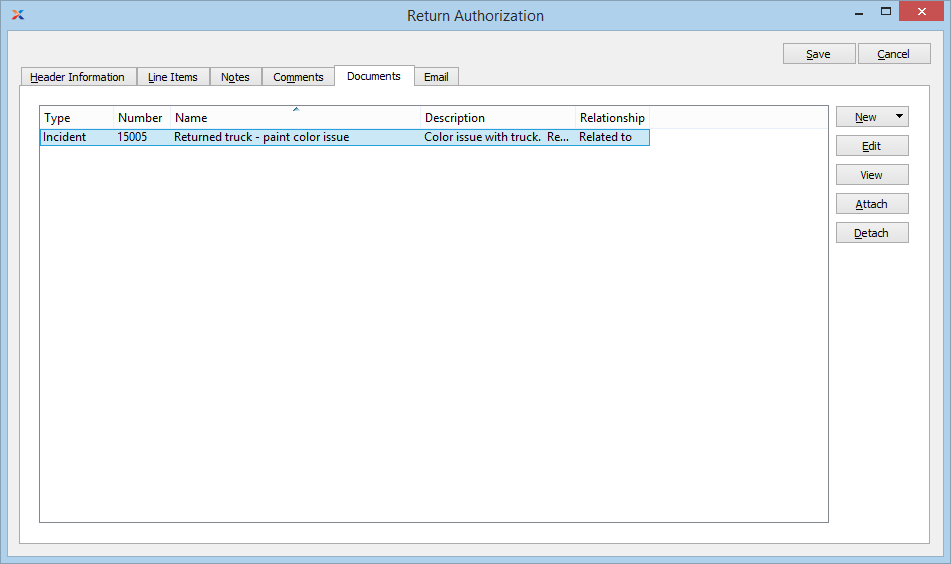
When associating documents, you are presented with the following options:
Select to create a new document and associate it with the current record. You may create the following document types:
Select to create a new image association.
Select to create a new fixed asset association.
Select to create a new maintenance order association.
Select to create a new incident and associate it.
Select to create a new project and associate it.
Select to create a new opportunity and associate it.
Select to create a new to-do and associate it.
Enables you to edit associated documents. The Edit screen is the same as that for creating a new document—except that when editing, the fields will contain document information. Double-clicking on a document will also bring you to the editing screen.
Highlight a document and then select this button to reach a read-only view of the Edit screen.
Select to associate already-existing documents. The following document types may be attached: contact, account, customer, employee, file, image, incident, item, opportunity, project, purchase order, sales order, vendor, web site, work order.
Highlight a document and then select this button to remove the association.
To associate already-existing documents, select the button. The following screen will appear:
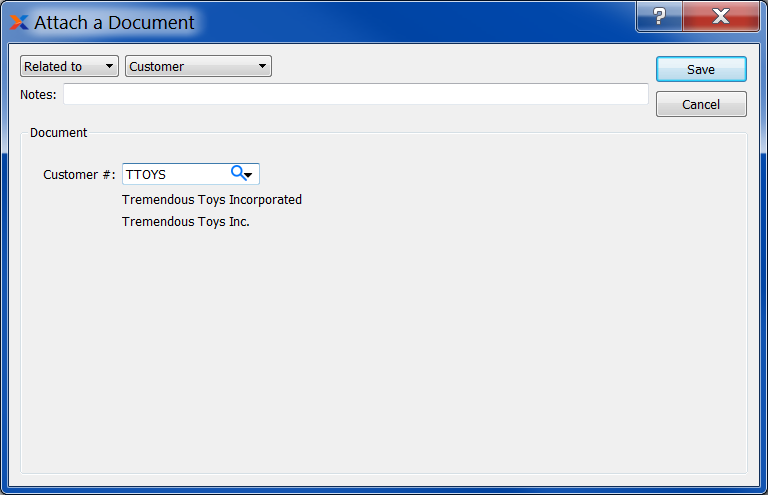
When associating already-existing documents, you are presented with the following options:
Indicate how the document is related to the current record. The following relationship options are available: related to, parent of, child of, duplicate of.
Specify the kind of document you want to associate. The following document types may be attached: contact, account, customer, employee, file, image, incident, item, opportunity, project, purchase order, sales order, vendor, web site, work order. When associating files, you will also be given the option to save the file to the database.
There is no file size restriction when saving files to the database. However, excessively large files could cause storage and performance issues.
Leave any notes on the document file as needed.
Use the lookup tool to identify the specific document you want to attach. The data entry options will vary depending on the document type you select.
To view email associated with the return authorization, select the tab. The following screen will appear:
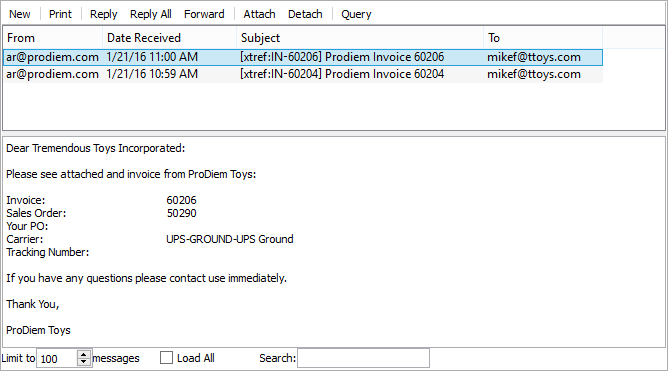
When viewing associated emails, you are presented with the following options:
Display lists associated emails.
The content of a highlighted email will be displayed here.
Specify the maximum number of associated emails you want to be displayed in the email list. If the list is extremely long, you may experience some slowness when opening the screen.
Select to load all associated emails into the list.
Enter a string of letters or complete words to search for matches in the list of associated emails. The search will scan through subject lines, To addresses, and From addresses.
The following buttons are unique to this screen:
Select to send a new email, using the default email program on your computer.
Highlight an email and then select this button to print a copy of the email.
Highlight an email and then select this button to reply to the email's sender, using the default email program on your computer.
Highlight an email and then select this button to reply to everyone associated with the email, using the default email program on your computer.
Highlight an email and then select this button to forward the email to another person(s), using the default email program on your computer.
Highlight an email and then select this button to attach an email associated with a contact in your contact list.
Highlight an email and then select this button to remove the associated email from the list.